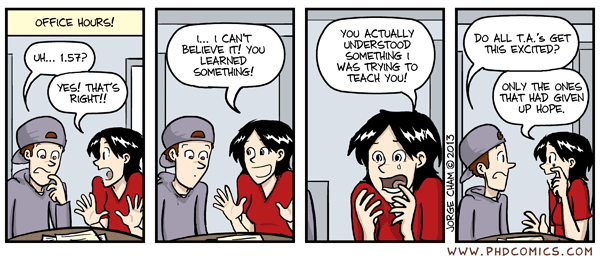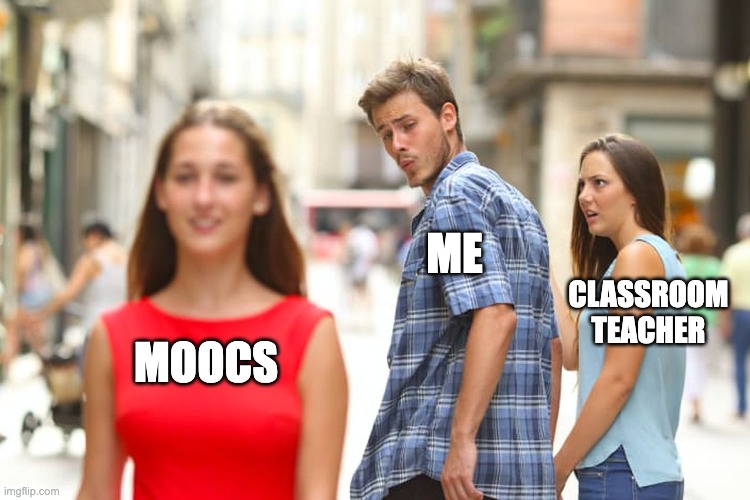A teacher does not teach, a student learns.
— snippet from this interview of Ustad Zakir Hussain
I’ll pose some how/what/why questions in the context of teaching.
How
The last couple of decades, especially the last few years, have seen dramatic changes in how information is communicated. A lot of learning happens in online communities, for instance, question-and-answer websites like Quora and StackExchange. Thanks to folks who invest time on these platforms, expert help seems to be nearer than ever before. Specialized and snark-free communities on Discord/Slack/Telegram are enabling peer-to-peer learning at global scale.
Books are beginning to be injected with exciting new technology: CodeMirror makes code interactive and runnable, while tools like PythonTutor can help with visualizing what happens behind-the-scenes when code is executed. Say what you want about JavaScript, but the interactivity that it brings to the written medium has helped make reading less passive. Some of my favorite interactive texts include Seeing Theory, Probabilistic Models of Cognition, courses on Brilliant, Mathigon, and essays from Nicky Case, Minute Labs, and others on Explorables.
And finally there are the online courses. At the time of this writing, it has been just a little over two decades since MIT’s Open Course Ware opened to the public. The early hype around MOOCs roughly coincided with my years in college and graduate school. As far as I remember, it was quite the thrill to have free-flowing access to online lectures — “taught by the best” — for several of the courses I was supposed to be doing as a part of my curriculum.
All this is to say that I walked into a career involving a substantial teaching component with plenty of hesitation. The delivery was/is still largely confined to classroom settings in broadcast mode. It is not entirely clear what this format has to offer over YouTube. Basic interactivity is being increasingly solved with questions built into video players. Peer learning is quite doable with WhatsApp/Slack/Discord groups and local chapter meetups. Scale in the context of assessments is somewhat addressed by peer evaluation. And then there are all the things you can do on YouTube that you can’t do with traditional lectures: find a teacher whose style resonates, find an accent you understand, replay, play at 2x, 0.5x, binge watch, don’t watch…
So: what’s the incentive for anyone to show up in a classroom at a fixed time, especially when said time is 8AM? This question became particularly relevant during the pandemic years: once the novelty wore off, almost nobody† showed up to lectures. If I was a student, I’d likely do the same. This remains largely an open problem in my mind, but here are some pointers that have kept me motivated about the conventional format.
- Classroom = theatre. I am increasingly treating it as a ground for practicing standup and magic skills. I should admit that this isn’t easy for a clinically shy person like myself, but I got used to making a fool of myself fast — that’s served well. I imagine that some of the fun that comes out performance-first lectures is hard to recreate with recordings and notes.
Totally. It's almost always a performance, irrespective of the class size. And the more you rehearse, the better it goes. At least that's what works for me.
— Manu Awasthi (@mnwsth) August 24, 2022
Some musings on teaching from a lunch talk awhile back: https://t.co/19vOXpxcjs
— Tim Roughgarden (@Tim_Roughgarden) April 6, 2021
In a classroom setting, I can nudge the audience to discover things for themselves. As far as I know, the interactivity in online materials can help with validating understanding, but not as much with developing it from first principles. My hope is for learners to walk out of a classroom with the confidence that they came up with parts of the material in the textbook on their own.
Again, this is hard to do in time-bound fashion, given that a lot of this kind of understanding comes from brooding and hours of messing around. I can only hope to convince the audience that the process is worth the trouble.
The opportunity to show that you care. For learners who may have struggles with and beyond the materials — classrooms, labs, and office hours afford opportunities for us to offer help.
This was a late realization for me personally: for the longest time, my own sense of self-doubt did not allow me to see that I could potentially be useful to someone else. While self-doubt remains, I have started to compartmentalize it enough to show up for others.
All this said, I believe online and remote formats have substantial potential for making quality education accessible at scale, and that it is only a matter of time before classrooms in their most conventional forms either become obsolete or a ruse.
I am going to attend college lectures from now on just to increase my attention span. The goal will be to sit for an hour without sleeping or getting distracted from mobile notifications.
— Priyansh Agarwal (@Priyansh_31Dec) September 5, 2022

What
It is also increasingly challenging to formulate a curricula gets people to the bleeding edge starting from the foundations. For instance, there is a growing sentiment that Machine Learning is the new Algorithms (or maybe not). On the other hand, the extent of involvement of “mathematics” in introductory CS courses is also up for debate.

How much theory is needed for competence in practice? How crucial is it to develop competencies that don’t have an immediately visible ROI? How frequently do we rewrite the textbooks based on developments in industry?
I once read a collection of answers to the question of what every computer science graduate should know on a Q&A site. As an aspiring graduate myself, I figured I should know what I should know. Unfortunately, I remember it as a mostly unnerving experience: it was a list that started with Voronoi diagrams and ended with incompleteness theorems, and a lot of things in between.
From the other side of the fence, for whatever it’s worth — the answer to this question remains elusive, mainly because I think it’s a context-heavy issue. For better or worse, there is a growing interest in computer science, and it will likely remain a non-trivial challenge to find an approach that is both maximally inclusive and sufficiently useful. I can only hope that between ruthless efficiency in teaching things driven purely by need and a curriculum flooded with random adventures, we can find an balance appropriate to our contexts!
Why
Given that everything that needs to be explained has more or less been done and dusted really well on the interwebs, personally, this is hardest question of the lot. Not from my own POV, that’s the easy bit - as pointed out here, it’s fun to go through the idea exchange process with a captive audience, and in my experience at least one party is sufficiently triggered at the end of it (hopefully in a good way).
The satisfaction that you get when you are able to explain a concept to someone who did not know it earlier is immense. Sometimes it could be straightforward, and sometimes it could be frustrating. But the end point is always the same - a smile on the faces of those students. Money can buy all the books, but can’t buy that smile.
Prof Dheeraj Sanghi, “Why I want to be a professor”

I am just not sure if we create enough of a net positive in a traditional classroom setup from a ROI perspective. Given the few good things that the internet has brought us, perhaps it is time to think beyond classrooms and focusing on making existing resources more accessible to everyone who’s interested.
Join the conversation
New blog, new post:https://t.co/c2lEHM0lTI
— Neeldhara (@neeldhara) September 5, 2022
Meanwhile — happy teachers day to everyone!


